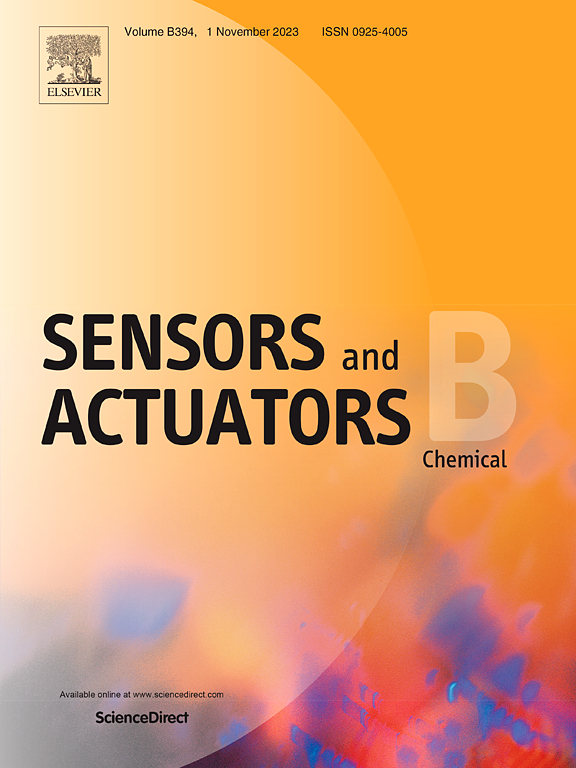4-MPBA@CuNCs用于红霉素的无印迹和高特异性荧光视觉传感
IF 8
1区 化学
Q1 CHEMISTRY, ANALYTICAL
引用次数: 0
摘要
在本研究中,我们制备了具有聚集诱导发射(AIE)特性的4-巯基苯基硼酸(4-MPBA)修饰的铜纳米簇荧光探针(4-MPBA@CuNCs),用于红霉素(ERY)的无印迹视觉传感,并建立了一种新的特异性检测ERY的传感策略。通过实验与理论计算相结合,阐明了4-MPBA@CuNCs荧光探针对ERY特异性识别和应答的机制。4-MPBA@CuNCs上的硼酸基团作为识别体,与ERY上的顺式-1,2-二醇发生酯环化,从而降低了4-MPBA@CuNCs-ERY配合物的溶解度,引发了纳米团簇的聚集诱导发射(AIE)。该方法实现了ERY的荧光开启检测,检测线性范围为0.05 ~ 100 μM,检出限为0.042 μM。值得注意的是,即使ERY浓度低至0.05 μM,肉眼仍能检测到。通过与智能手机结合进行在线视觉传感数据分析,荧光探针可以精确快速地区分不同浓度的ERY。该荧光探针还成功应用于实际医疗废水、ERY处理后的痤疮皮肤清洗出水和红霉素分散片中的ERY检测,具有较高的准确性和稳定性。这项工作为现场、低成本和快速的ERY检测提供了一种创新的方法,为利用配体调节的金属纳米团簇进行抗生素的快速识别和传感提供了新的视角。本文章由计算机程序翻译,如有差异,请以英文原文为准。

4-MPBA@CuNCs for imprint-free and highly specific fluorescence visual sensing of erythromycin
In this study, we facilely prepared a 4-mercaptophenylboronic acid (4-MPBA) modified copper nanocluster fluorescent probe (4-MPBA@CuNCs) with aggregation-induced emission (AIE) properties for the imprint-free visual sensing of erythromycin (ERY), and a novel sensing strategy for superb specific detection of ERY was established. The mechanism of specific recognition and response to ERY by the 4-MPBA@CuNCs fluorescent probe was clarified through a combination of experimental and theoretical calculations. The boric acid group on 4-MPBA@CuNCs served as a recognizer, undergoing ester cyclization with the cis-1,2-diol on ERY, which decreased the solubility of the resulting 4-MPBA@CuNCs-ERY complex and triggered the AIE of the nanoclusters. The developed method realized a fluorescence turn-on sensing of ERY with a detection linear range from 0.05 to 100 μM and a detection limit of 0.042 μM. Notably, even the concentration of ERY was as low as 0.05 μM, it still could be detected by naked eye. By combining with smartphones for online visual sensing data analysis, the fluorescent probe enabled precise and rapid differentiation of ERY with different concentrations. The fluorescent probe was also successfully applied to the detection of ERY in real medical wastewater, and effluent discharged from cleaning the ERY treated acne skin, and erythromycin dispersible tablets, demonstrating high accuracy and stability. This work provided an innovative approach for on-site, low-cost, and rapid ERY detection, offering new perspectives on the use of ligand-regulated metal nanoclusters for rapid antibiotic recognition and sensing.
求助全文
通过发布文献求助,成功后即可免费获取论文全文。
去求助
来源期刊

Sensors and Actuators B: Chemical
工程技术-电化学
CiteScore
14.60
自引率
11.90%
发文量
1776
审稿时长
3.2 months
期刊介绍:
Sensors & Actuators, B: Chemical is an international journal focused on the research and development of chemical transducers. It covers chemical sensors and biosensors, chemical actuators, and analytical microsystems. The journal is interdisciplinary, aiming to publish original works showcasing substantial advancements beyond the current state of the art in these fields, with practical applicability to solving meaningful analytical problems. Review articles are accepted by invitation from an Editor of the journal.
 求助内容:
求助内容: 应助结果提醒方式:
应助结果提醒方式:


